The rated voltage of the vehicle power battery is usually above 300V, and even some vehicles reach more than 600V, which is the reason for the safety design of high voltage wiring harnesses. High voltage architecture: is a demand-oriented, functional implementation of the way as the leading platform technology solution. This paper mainly introduces the safety and architecture of the low voltage wiring harness, the following is the main body.
In the power cable system of the vehicle, we can divide the high-voltage wiring harness into several components in the following table.
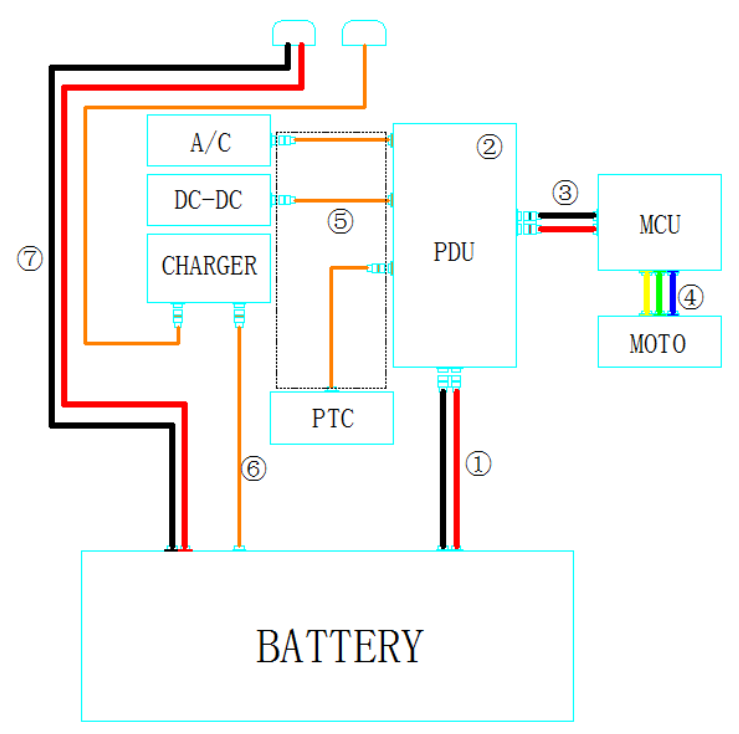
| No. | Cable Assembly |
| 1 | PDU POWER HARNESS ASSYEMBLY |
| 2 | HV POWER DISTRIBUTION UNIT |
| 3 | MCU POWER HARNESS ASSYEMBLY |
| 4 | ELECTRIC MOTOR POWER HARNESS ASSEMBLY |
| 5 | JUNCTION BOX POWER HARNESS ASSEMBLY |
| 6 | CHARGING HARNESS ASSEMBLY |
| 7 | FAST CHARGING HARNESS ASSEMBLY |
However, the division of the wiring harness and the structure of the vehicle and the assembly process have a great relationship, do not have to stick to the above division form. Strive to achieve simple structure, convenient disassembly, beautiful layout, good fixed protection. In addition, in the design of the wiring harness, the local wiring harness needs to be in the form of conversion cables, which needs to be determined by the specific model.
02PART High voltage wiring harness features and safety design requirements
The operation characteristics of pure electric vehicles determine the particularity of high-voltage wiring harnesses. Compared with low-voltage wiring harnesses, high-voltage wiring harnesses have the following characteristics:
1. High voltage. The rated voltage of the vehicle power battery is usually more than 300V, and even some vehicles reach more than 600V, requiring the insulation material of the wiring harness assembly to have higher voltage resistance.
2, sealing. For example, the bus output connector has a low position and needs to face the erosion of water and dust, requiring a higher level of protection. Connector protection level generally requires IP67, some special parts require IP6K9K.
3, high heat resistance. When the vehicle runs with high current, the Joule effect will generate heat, resulting in an increase in the temperature of the wiring harness itself and its surroundings, which requires better heat resistance of the wiring harness. The heat resistance of high pressure wire harnesses is usually up to 125 ° C or even higher.
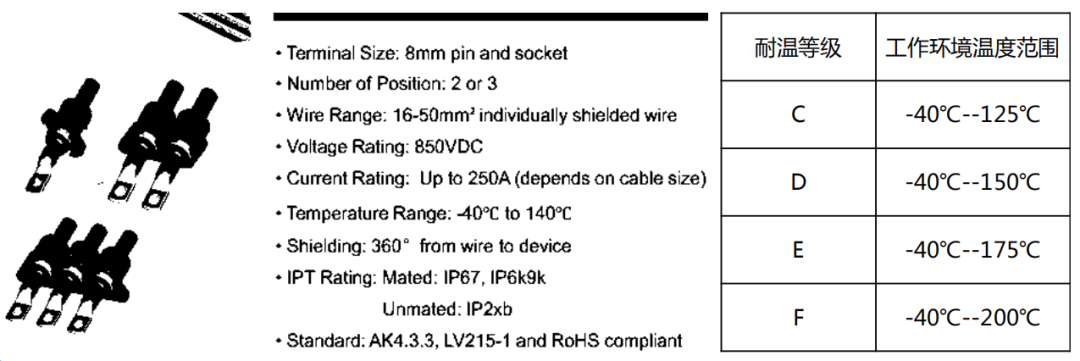
4, anti-electromagnetic interference. When the electric vehicle is running, the repeatedly changing electrical load and the widely used frequency conversion technology in the system cause the sharp fluctuation of the harness voltage, current and frequency, resulting in large electromagnetic interference. Usually, the high-voltage connectors are 360° shielded, and the high-voltage cables are shielded.

5. Durability. The high voltage wire harness should have the performance of temperature resistance, weather resistance, corrosion resistance, vibration resistance and cable scratching resistance, and have a large safety margin and connection life to ensure that the vehicle can run reliably for a long time.
Connector: The role of the wire harness connector is to ensure that the cable and electrical equipment can be easily and reliably connected and disassembled. The selection of high-voltage connectors for pure electric vehicles usually has the following requirements:
1) Electrical properties. In order to cope with the use of high voltage and high current environment, connector terminals are usually specially designed to increase the contact area and reduce the contact impedance; With the application of shielded cable, the connector is mostly made of metal material or the inner design shielding structure to achieve the structural design of 360° shielding; According to the high voltage safety standard, the voltage resistance of the connector must be ≥2U+1000V (AC), and the insulation resistance must be ≥20MΩ.
2) Environmental performance. Connector operating temperature is usually required to be -40~125℃; Corrosion resistance, oil resistance, plastic material with flame retardant performance; The minimum protection level of the connector is IP67, and some special requirements need to reach IP6K9K.
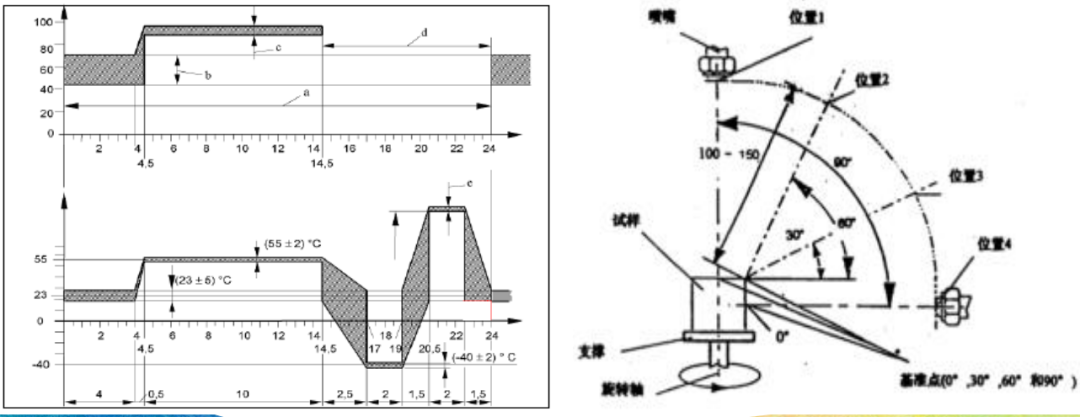
3) Mechanical properties. Connector resistance to vibration and shock; With self-locking and anti-stay structure; Life ≥500 times; With loop interlock structure design.
Safety requirements: high voltage warning signs, B and voltage wire marking requirements
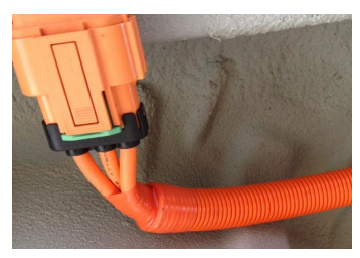
Standard: Cables and harnesses are orange, and high-voltage connectors can be distinguished by the harnesses connected to them. Standard: Yellow base, black frame, black arrow
High voltage connector safety design requirements: High voltage connectors should not be opened without the use of tools, except for the following three cases:
a) After the high voltage connector is separated, it should meet the protection level requirements of IPXXB;
b) The high voltage connector requires at least two different actions to separate it from the mutual butt end, and the high voltage connector has a mechanical locking relationship with some other mechanism, and the locking mechanism must be opened by using a tool before the high voltage connector is opened;
c) After the high voltage connector is separated, the voltage of the live part of the connector can be reduced to not more than 30 Va.c. (rms) and not more than 60 Vd.c.
High voltage PDU safety design requirements: a) in the passenger compartment and cargo compartment should meet the IPXXD protection level requirements, and outside the passenger compartment and cargo compartment should meet the IPXXB protection level requirements;
b) High voltage warning sign, tool disassembly or cover protection design, 1 s after the shell is opened to meet the following requirements: - Circuit voltage should be reduced to no more than 60 Vd.c.
c) The connection impedance between the PDU shell and the level station should not be greater than 0.1Ω
Requirements for charging socket: IP55 when plugged in, IP54 when covered with protective cover
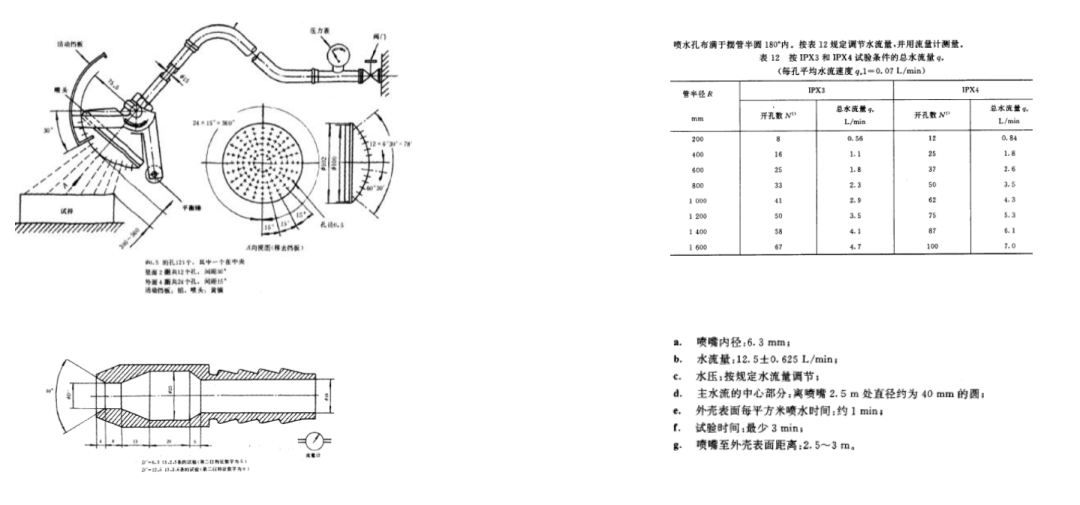
Requirements for AC charging socket: When disconnected, the insulation resistance is greater than 1 Mω, and a terminal is connected to the level station.
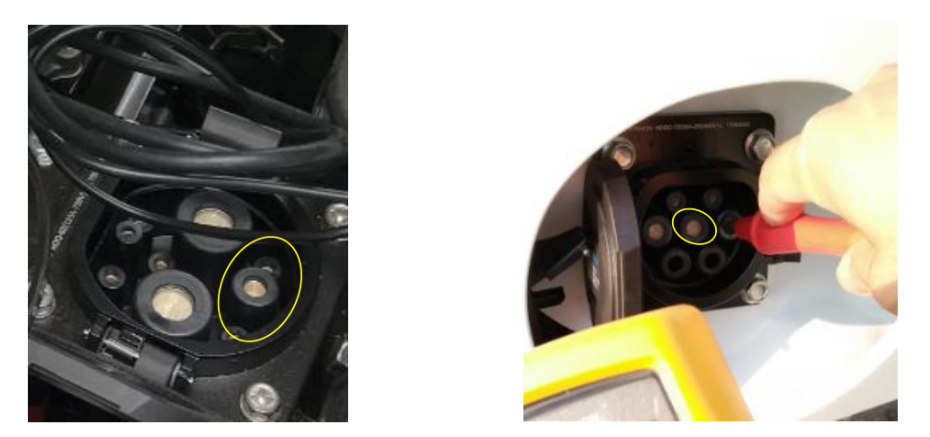
03PART High voltage architecture
High voltage architecture: is a demand-oriented, functional implementation of the way as the leading platform technology solution. ▲ Support each other with the system platform;
▲ Based on the needs of platform models, taking into account cost, quality, performance and other factors, comprehensive balance and optimization results.
▲ Including high-voltage components highly integrated, power distribution, system circuit principle, functional safety and other design content.
High voltage electrical system architecture design principles Functional requirements → high voltage safety → cost control → expansion and upgrading → after-sales maintenance (priority gradually reduced)
| High Voltage Component | Working condition | |||
| Driving | Slow charging | Fast charging | Remote air conditioning | |
| PTC | √/X | √/X | √/X | √/X |
| A/C | √/X | √/X | √/X | √/X |
| DC-DC | √ | √ | √ | √ |
| MCU | √ | X | X | X |
| OBC | X | √ | X | X |
| DC Charger | X | X | √ | X |
| Note: "√" means that the part works, "X" means that the part does not work | ||||
| Note: Air conditioning can be turned on during charging (including fast charging and slow charging), which is conducive to user experience | ||||
Distributed architecture:
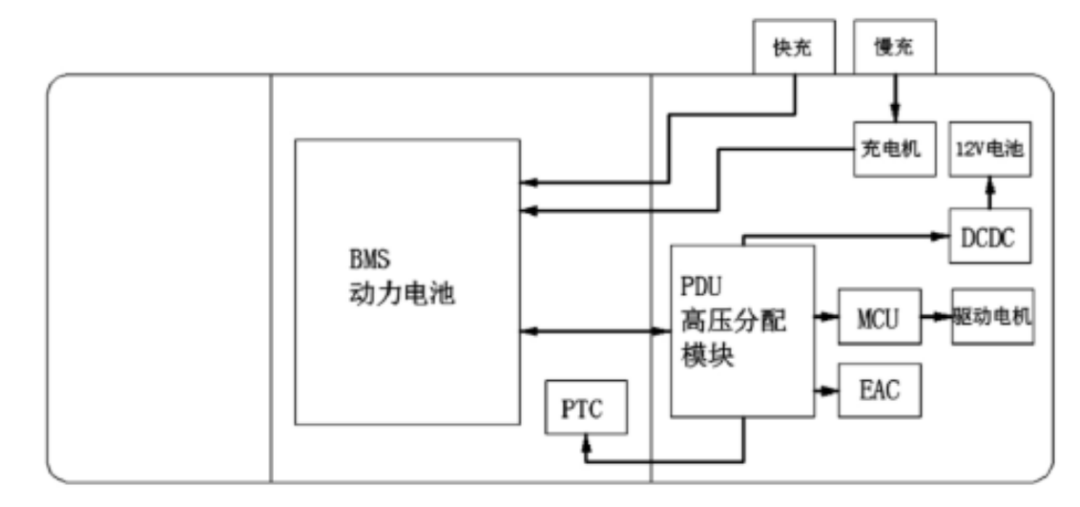
3-in-1 integrated architecture: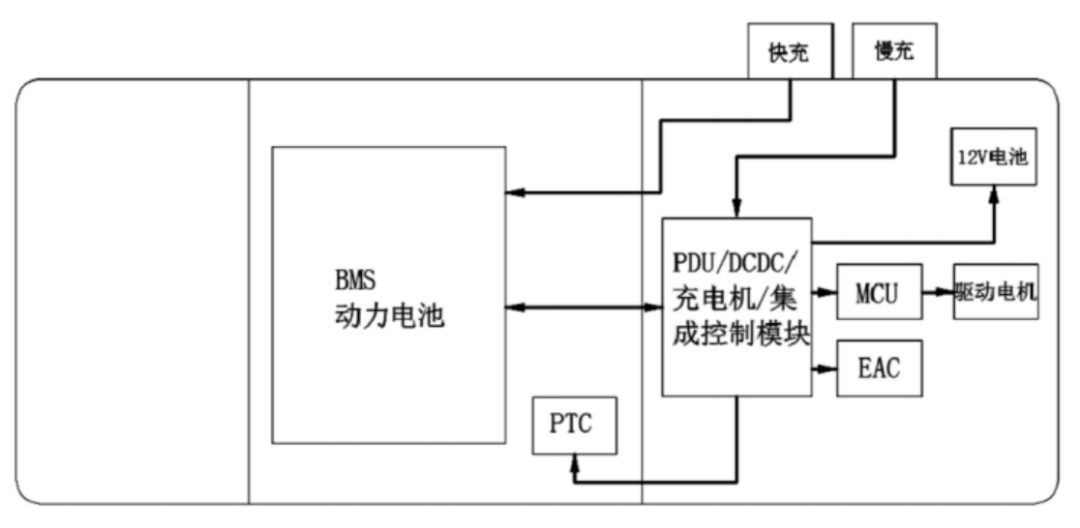
5-in-1 integrated architecture:
| Name | High voltage and high current connector(>150A) | High voltage low current connector(<150A) | ||
| Application | Quantity | Application | Quantity | |
| Distributed architecture | MCU, power battery, drive motor, fast charge, PDU | 7 Pairs | OBD、DCDC、PTC、EAC、PDU | 10 Pairs |
| 3-in-1 integrated architecture | MCU, power battery, drive motor, fast charge, integrated control module | 7 Pairs | PTC、EAC、PDU | 6 Pairs |
| 5-in-1 integrated architecture | Power battery, drive motor, fast charge, integrated control module | 7 Pairs | PTC、EAC、PDU | 6 Pairs |
It can be seen from the above table that the number of connectors of different high-voltage architectures is different: the five-in-one integrated architecture of high-current connectors is reduced by 2 pairs compared with the distributed architecture and three-in-one integrated architecture, and the cost is reduced by about 28%; The small current connector 5-in-1 integration architecture and 3-in-1 integration architecture are 4 pairs less than the distributed architecture, and the cost is reduced by about 40%.